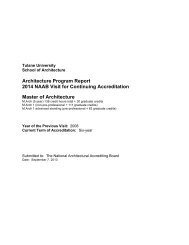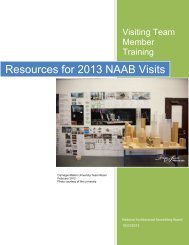Architecture Program Report Tulane University New Orleans ...
Architecture Program Report Tulane University New Orleans ...
Architecture Program Report Tulane University New Orleans ...
You also want an ePaper? Increase the reach of your titles
YUMPU automatically turns print PDFs into web optimized ePapers that Google loves.
centers primarily on the recognition of the needs and aspirations of the<br />
client. Recognition of this responsibility is seen in the fundamental<br />
concern for the relationship between users and the built environment—a<br />
concern that is brought to bear on much of the critical discourse of the<br />
school.<br />
The parameters for achieving registration are not inculcated as a<br />
separate, identifiable concern; rather, the stress on issues associated<br />
with technical competence, the acquisition of skills, and public welfare<br />
permeate the curriculum. The subject of review and critique, these issues<br />
are presented in the introduction to architecture course and are<br />
reinforced in the early phases of the design studio. This is followed by an<br />
increasing awareness of these concerns in later years, whereby a<br />
general attitude is abetted through the application of coursework<br />
specifically associated with the areas of technology, skills, human factors<br />
and life safety. While students understand architecture as a matter of<br />
both ‘making’ and knowledge in the first two years, this position is<br />
succeeded by a more articulate view of the architect as a responsible<br />
and responsive professional entrusted with the welfare of the numerous<br />
'’clients”: individuals, communities, and the environment.<br />
Requirements for graduation, the professional concerns course and a<br />
professional concerns elective—usually taken in the student’s fourth- or<br />
fifth-year—features two lectures on registration, one by a member (or<br />
director) of the Louisiana State Licensing Board and one by the<br />
Louisiana State Head of the Intern Development <strong>Program</strong>. IDP<br />
information is distributed during this presentation and again in the final<br />
semester of thesis-year. Bruce Goodwin, our IDP liaison, also enlists<br />
members of the State Licensing Board to give presentations during the<br />
school year.<br />
In addition, students are prepared for practice and registration by the<br />
two-summer internship (“Summer Field Work”) requirement. This<br />
curricular requirement is intended to emphasize the nature of<br />
professional education and practice, and the necessary preparation for<br />
licensure.<br />
<strong>Architecture</strong> Education and the Profession<br />
<strong>Tulane</strong> School of <strong>Architecture</strong> actively promotes the idea of the architect<br />
as an ‘enlightened professional’. Throughout the history of the program,<br />
there has been a strong relationship between practitioners and<br />
educators; indeed, most of the full-time faculty—along with all part-time<br />
faculty—are actively engaged in architectural practice. Drawn from local,<br />
regional, and nationally recognized offices, reviewers of student work are<br />
by and large practitioners of note. Many of these individuals engage in<br />
traditional practices, while others have advanced careers in fields<br />
associated with architectural practice: preservation, politics, real estate,<br />
government, urban planning, environmental law, community advocacy,<br />
and the fine and allied arts. Hence, students are engaged throughout the<br />
course of their educational career with the responsibilities and activities<br />
associated with practice—not only from the point of view of practitioners,<br />
but from the point of view of the numerous constituent groups that














